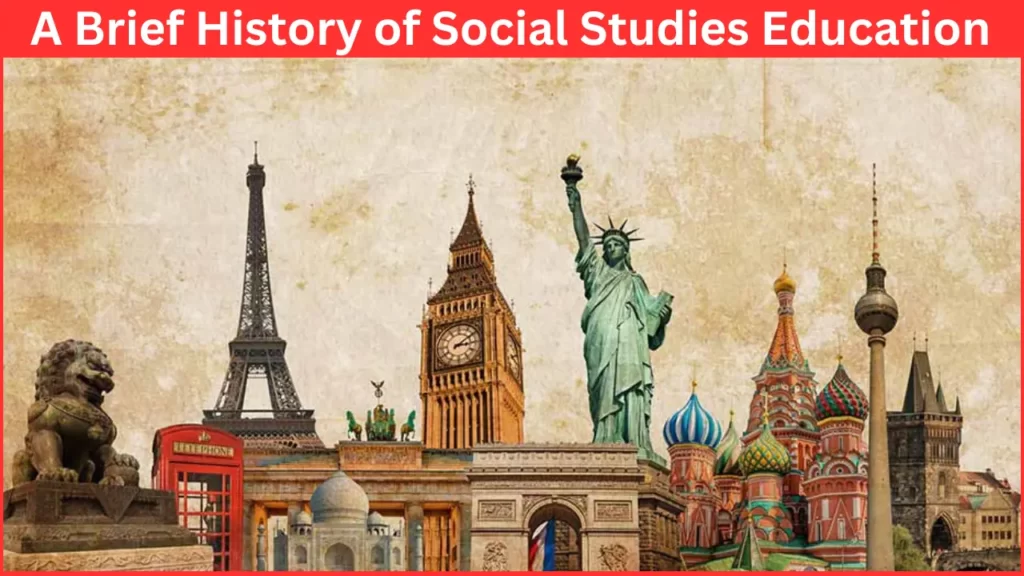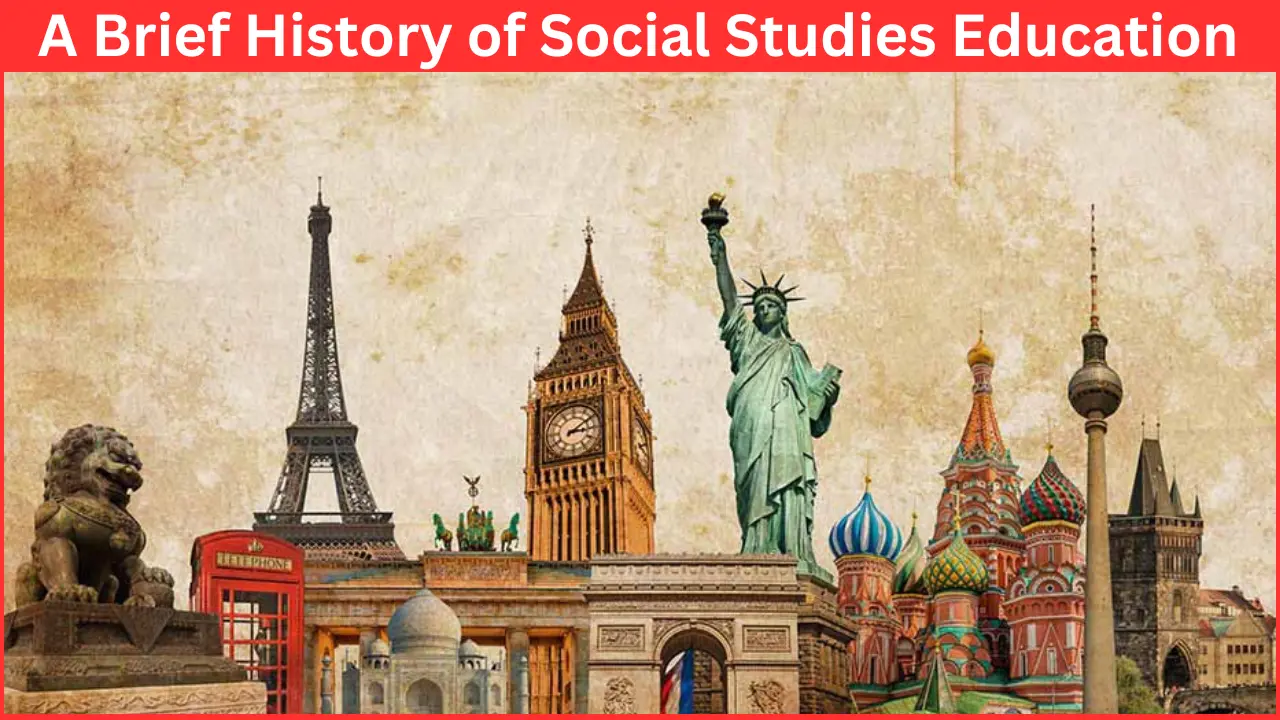
The ability of “man as a member of social groups” to negotiate the issues, problems, and concerns that such modernity created was the foundation upon which all that America had become at the turn of the century (i.e., its inventive genius, its unlimited resources harnessed, its great commercial and industrial power, its magnificent cities, and its teeming humanity) rested. In light of these facts, American society’s educational requirements could only be met by focusing on “man’s” current social aspects, not his past.
The engine of American education would be put to use here to benefit the populace. Social studies, a new flexible and unstructured curricular program developed in the twentieth century to meet the requirements of this progressive new society, emerged as children were released from their bolted-down seats from the nineteenth century. Educators used this loose social studies concept to create experimental curricula throughout the twentieth century.
The re-invention of the social studies is not as absurd as it initially seems, despite being an ambitious undertaking. Actually, as we will pressure in this book, that the sociologies were concocted as of late, and that implies that they have not generally existed in their current structure and accordingly (2) that they need not necessarily exist in their current structure. As a matter of fact, we know that essentially all associations and establishments are in a practically nonstop pattern of self-assessment and self-creation nowadays.
Another group of “social studies” figures drew inspiration and content from the older traditional history curriculum that was introduced at the end of the nineteenth century, often in stark opposition. Social studies, like any other educational innovation, did not emerge overnight. Its creation was as much a response to winning educational programs as it was a development. A history-centered program that called for formal studies in ancient, medieval, modern, and American histories as gateways toward effective citizenship was what existed in most high schools prior to social studies for the purposes of citizenship education.
This program was developed in 1899 by the Committee of Seven and was centered on the subject of history. Even though the Committee of Seven report did not include as much specific content as modern state history standards from states like California, Massachusetts, and Virginia, or even the National Standards for History, which were recently rejected, publishers still provided textbooks that were abundant with dates, events, personalities, and issues that were all arranged chronologically and largely standardized across the industry. “The fact of the matter is that a textbook intended for high school use in history published between 1900 and 15 had hard “sledding” if it failed to claim that it conformed to the report of the Committee of Seven,” Rolla Tryon wrote in 1935, when the textbook was the curriculum. “
Tryon likewise noticed that “for no less than twenty years after [the Board of Seven report appeared], secondary school courses in history in the US were right around 100% directed by it. Indeed, even today [1935] more than an age after the distribution of the report, its impact is overwhelming in likely 33% of the secondary schools of the country. The history-centered curriculum was attacked by social studies rebels for more than a decade before the 1916 Committee on Social Studies completed its work, despite the virtual lock on schools.
It is encouraged and required of organizations and institutions to evaluate themselves, reevaluate their policies and procedures, “think outside the box,” and incorporate perspectives from often-ignored and invisible constituencies like subordinated races, ethnicities, languages, genders, religions, age groups, and so on. As such, on the grounds that we have done things a specific way before — whether “we” are a business, a school, a nation, or a scholarly discipline — doesn’t imply that we should keep on doing things that way.
In response to a developing number of evaluates that held the set of experiences educational plan as inadmissible to the tensions and real factors of present day life, antiquarian John Bach McMaster answered certainly in 1905, that in the “interaction of Enfranchising the outsider [and any remaining children] we should fill their brains with current realities of American history which they may not comprehend, however which they should take as such a lot of medication. On the other hand, in 1907, social worker Jane Addams, who had experience settling new immigrants in Chicago, argued that “the usual effort to found a new patriotism upon American history is frequently an absurd undertaking.”
The social studies movement emerged in the void left by these two stances—the hard edge of Americanization applied to children and the more progressive stance based on children’s needs and interests. Albeit social investigations scholars had contended powerfully to the point of acquiring the help of the U.S. Agency of Schooling as well as the supporting Public Training Relationship in propelling social studies, the set of experiences educational program didn’t vanish. In point of fact, as Tryon pointed out, many schools continued to offer the Committee of Seven’s history curriculum throughout World War II.
Additionally, this author can confirm that his high school continued to offer the Committee of Seven’s four-block curriculum into the 1960s. Regardless of history’s strength, the pundits’ guide that set of experiences’ commitment toward the advanced educational plan must be valuable on the off chance that it cast light on contemporary issues demonstrated powerful, if not telling. Social studies practitioners relentlessly pressed their demands that every content area must pass the test of social utility as a subject area that contributed to understanding and resolving contemporary social problems, despite the fact that the stewards of history sought to maintain the traditional history curriculum to “train the intellect.”
Some people eventually came to think of social studies as history, geography, civics and government, economics, and other content areas that were loosely constructed around the teaching of citizenship, given the flexibility of school systems to determine their own methods and programs for citizenship education. Others saw social examinations as a remarkable field by its own doing where youthful residents mastered the interaction abilities furthermore, approaches vital for citizenship.
It didn’t matter whether a local school district used one of dozens of social studies approaches to citizenship education or a history-center approach until the 1990s, when the standards movement took hold in most states. tive programs. We had voyaged round trip. While many state standards simply changed their curricula into content-centered standards with social studies remaining as the masthead, others simply changed their curricula to reflect a renewed interest in history-centered (and other discrete subject matters). Still other people kept the diverse social studies.
It will be noted by readers that some thinkers, like Adam Smith and Karl Marx, have contributed significantly to more than one field. In addition, all of the current social sciences in the Western world are influenced by ancient thinkers like Plato and Aristotle. These social sciences all developed from a common tradition of philosophy and theology that defined them and continues to define them today. For sure, it will turn out to be certain that a driving worry, past simply learning genuine things and obtaining commonsense instruments for overseeing society, has been profound quality, that is to say, considering and making the “great individual” and the “great society.”
Whether history-focused models will return in force or the varied social studies will recuperate ground lost in the principles based development still needs to be replied. However, over the past century, one thing has remained constant: History and social studies have not completely disappeared from schools, regardless of whether history-centered models were disguised as social studies or whether history-centered initiatives are currently dominating social studies programs.
The inquiry presented here isn’t the reality that social examinations makes due in such places as government funded schools, reading material, or educator accreditation programs, be that as it may, whether social examinations ought to get by? This is not the place to discuss the numerous conflicts that arose between social studies and history, nor should it feature the numerous curricular models that were issued as social studies curricula (readers should consult other accounts for such treatments).
All that needs to be said is that, despite the fact that the eclectic wing of social studies continued to drift from one curricular fad to another, the history-centered, disciplinary-focused wing of the field remained entrenched in certain areas and was poised to Definitely, as the principles and responsibility development built up forward movement in the end many years of the 20th 100 years, the varied social examinations scholars mixed to keep up with their field’s importance in the schools at the approach level.
The loose concept of social studies became a problem as policymakers and parents demanded a clearly defined curriculum with mechanisms to measure teaching results. Social studies’ flexibility, adaptability, contemporary orientation, and lack of a coherent core of knowledge—which had been its mainstays over time—came suddenly to be liabilities.
The field of social studies had put its money into a number of fads: life alteration, expanding environments, inquiry-based instruction, value clarification, issues-centered instruction, reflection, and critical thinking are just a few examples. Culture and history were conveyed through some of these shows; others, critical social science research; Others attempted to replicate scholarship in social science.
Personal growth through life experiences was an aspect of some of the programs; Others were intended to utilize these models for the study of social issues or the enhancement of students’ reflective skills; Still others tried to get students to become social activists. The older, more conventional history concept served as a guide for many policymakers when it came time to retool school curricula. Due to the content-centered nature of their state standards, many states changed the names of their programs.
For instance, Pennsylvania used the more descriptive term “citizenship education” instead of the social studies term for its content-centered standards in history, geography, civics, government, and economics for state certification. The term “social studies” was still used in some states even though they switched to content-based standards. However, in their state standards, a number of states, including Minnesota, Wisconsin, and Washington, kept the older, ambiguous definition of social studies.
Reviewing how this seemingly resistant field has evolved over the past two decades would be instructive if the state standards movement has affected how social studies are taught and viewed in various states. The most powerful assault on the varied idea of social examinations was sent off in the 1983 distribution of A Country In danger.
Policymakers pressed educators to reinstate subject-based instruction in this instance. The authors of A Nation at Risk, members of the National Commission on Excellence in Education, targeted the alleged cause of the “rising tide of mediocrity that threatened our very future as a Nation and a People” by specifically calling for “improved teaching and learning” in economics, geography, and history. curricula “that no longer had [a] central purpose,” ineffective, “diluted and diffused,” and “smorgasbord.” That criticism was perfect for social studies.
